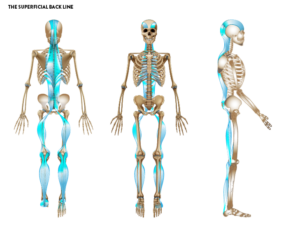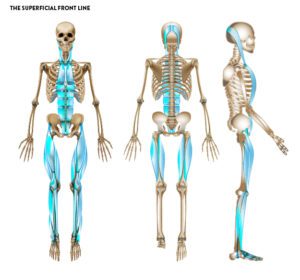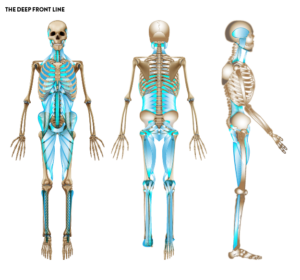Fascia is a connective tissue that helps our body hold its shape by wrapping in and around all tissues of the body. Without fascia, we would literally be a skin bag full of bones and organs all sloshing around with no distinctive shape. Fascia is so pervasive and that if we made all other tissues disappear and just left the fascia we’d look exactly the same.
Over the last 20 years or so, a group of kinesiologists and deep tissue massage therapists took it upon themselves to become leaders in human dissection. One man in particular, Tom Myers, pioneered in the field, and wrote a book called Anatomy Trains. He is responsible for proving that there are denser lines of fascia that run through the body and connect muscle groups to each other.
This helped explain why someone who was having a tension headache could get a massage on the bottom of their foot and feel their tension headache go away. The fascial line runs from the bottom of the foot up the back to the skull, so tension in the foot actually does relate directly to the back of the head.
Four Lines of Fascia
There are four fascial lines that you should be concerned with. The above example is about the superficial backline. The fascia at the bottom of the foot runs up the calves, attaches to the hamstrings, then the sacrotuberous ligaments, then the erectors, all the way through to the skull. It reaches the suboccipitals around the top of the head and terminates on the frontalis muscles at the front of the head. If any point along this line gets really tight, it tugs on everything below it and everything above it, sometimes resulting in tension headaches. That’s why a foot reflexology session can sometimes cure shoulder pain, neck pain, and migraines.
In order to discover this line of fascia, Myers and his peers had to dissect fresh cadavers. These are cadavers that are embalmed rather than preserved in formaldehyde so that the tissue is still fresh. Working with these is closer to working with what our bodies are actually made of.
Myers removed the muscles from the bone but kept all the connections of the fascia around the muscles. When Myers and a lab tech pulled on the muscles bundled in the fascia, they found that they would not come apart.
Our Bodies are Not as Independent as We Were Taught
In standard anatomy, we do not think of the hamstrings as being a single element with the calves, the back or the back of the head. We were taught that they are independent, isolated units that do a specific action, and that’s helpful up to a point. But we also need to look at the entirety of fascial lines to be the most effective in practice.
What makes resistance stretching remarkable is that teaches you to differentiate between stretching fascia or stretching the direct muscle, and why. You’ll come to understand that this is what differentiates resistance stretching from something like yoga, which is incredible at stretching fascial lines but completely disregards muscle tension. You see many of the injuries in yoga related to dislocations and hypermobility. This can cause the joints to be out of whack, and can ultimately cause the same problems that occur with total immobility.
The Superficial Backline and Frontline of Fascia
 The superficial back line covers hamstrings, calves, the entire spinal erectors, and some of the neck muscles adjacent.
The superficial back line covers hamstrings, calves, the entire spinal erectors, and some of the neck muscles adjacent.
 The balancing line to the superficial back is the superficial front line. This covers the abdominals as they relate to the sternocleidomastoid, almost all the way up into the temporal muscles, and the nuchal ligament that runs around the back of the skull. It then covers the quads, shins, and top of the foot.
The balancing line to the superficial back is the superficial front line. This covers the abdominals as they relate to the sternocleidomastoid, almost all the way up into the temporal muscles, and the nuchal ligament that runs around the back of the skull. It then covers the quads, shins, and top of the foot.
The Lateral Line of Fascia
 The third line is called the lateral line. This primarily covers the glutes, including some of the glute max, the glute medius, TFL, and the tight band of tissue down the outside of the leg. It also covers the peroneals, which are a part of the calf that runs right under the foot to the base of the big toe. Without this strong string of connective tissue, you wouldn’t be able to push off your big toe to walk. Instead, your foot would collapse and you’d have a terrible gait pattern.
The third line is called the lateral line. This primarily covers the glutes, including some of the glute max, the glute medius, TFL, and the tight band of tissue down the outside of the leg. It also covers the peroneals, which are a part of the calf that runs right under the foot to the base of the big toe. Without this strong string of connective tissue, you wouldn’t be able to push off your big toe to walk. Instead, your foot would collapse and you’d have a terrible gait pattern.
Those are the three kinds of superficial layers, but the most important line of tissue is the deep frontline. The deep frontline of fascia basically becomes the core of the human body. When people talk about core, it’s not really the abs at all.
The Deep Frontline of Fascia
 If you look at the deep frontline, you’ll see it includes the interosseous muscle in the shin, as well as huge muscles like the adductor magnus, all the short adductors, the iliacus, the psoas, the nuchal ligament along the front of the spine, and all the pelvic floor muscles. It also covers the quadratus lumborum, and sections of transverse abdominis, which is truly a core muscle, plus the diaphragm, the scalenes, and all the muscles that stabilize the rib cage from above, leading up into the face and the masseter and temporalis muscles. With our society and the way that we live our lives, the fascia of the deep frontline is usually the reason for most of our hip and low back problems.
If you look at the deep frontline, you’ll see it includes the interosseous muscle in the shin, as well as huge muscles like the adductor magnus, all the short adductors, the iliacus, the psoas, the nuchal ligament along the front of the spine, and all the pelvic floor muscles. It also covers the quadratus lumborum, and sections of transverse abdominis, which is truly a core muscle, plus the diaphragm, the scalenes, and all the muscles that stabilize the rib cage from above, leading up into the face and the masseter and temporalis muscles. With our society and the way that we live our lives, the fascia of the deep frontline is usually the reason for most of our hip and low back problems.
How Fascia Creates Scar Tissue
Fascia has a very distinct quality that can be demonstrated with a simple analogy. If I cut my skin open and the skin splits apart, I either need to get stitches or a strong bandage to hold those two sides together so they can heal. As long as I don’t move them, the scar tissue will knit that skin back together.
The lack of motion is what develops scar tissue, but scar tissue doesn’t know the right way to lay down. It just knows that if you’re not moving, it’s going to try and heal into that position. If I sit for hours a day, my fascia will try to heal me into a seated position, regardless of what the muscles are doing. So when people stand up and really stretch, it’s working out a deep frontline of fascia healing into a seated position.
To learn how to make fascia healthy, we can use the cut analogy. A cut will never heal if it keeps opening. The movement will prevent the scar tissue or fascia from forming.
Is Your Wetsuit Too Tight?
That’s obviously not what we want with a cut, but it is what we want with the fascia of the body. If I consistently move my body through healthy ranges of motion every 30 to 60 minutes, I can get a full body fascial release and prevent tension from building.
Without regular stretching and movement, you become encumbered by what we call the wetsuit of the body. I like to compare fascia to a full-body wetsuit. If you wear a wetsuit that’s too tight, it will restrict motion, just like a tight fascia restricts motion in the muscular system.
Having fascial tension for too long limits your movement and your muscles can only operate within a small range of motion, resistance stretching provides you with adaptive shortening of the muscles for whatever the fascia can allow.
For now, just understand that fascia relates to multiple, distinct muscle groups. Whenever we use a posture-based stretch with resistance, we’re doing resistance stretching on the connective tissue more so than the muscles.
Stretching Both Fascia and Muscle
For example, we can put the biceps in a position where the fascia is pliable and I was wearing a wetsuit, my arm was in front of me, it wouldn’t stretch the wetsuit material. But if I put my arm all the way behind my body the material would tighten. The same is true of stretching the body. With the arm behind the body, I’m stretching both fascia and muscle, but primarily the fascia.
Resistance stretching exercises will put your body in mundane positions to target the muscle, and dynamic positions to stretch the fascia. If you want to learn even more about fascial anatomy, I suggest checking out Tom Myers’ book, Anatomy Trains. A simple skim of the text can give you a lot of little helpful nuggets, including information on the concept of bio-tensegrity, which is a cornerstone of Train with Rocco philosophy.

